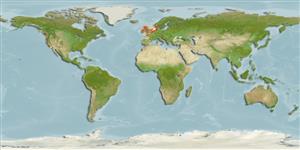Common names from other countries
Environment: milieu / climate zone / depth range / distribution range
Ekologi
. Subtropical
Northeast Atlantic. Introduced in the Mediterranean. Questionable in the Pacific.
Length at first maturity / Size / Weight / umur
Maturity: Lm ? range ? - ? cm
Known from infralittoral zones (Ref. 85338). Solitary (Ref. 2377).
Life cycle and mating behavior
Kematangan | Reproduksi, perkembang biakan | Pemijahan | telur-telur | Fecundity | Larva
Members of the class Anthozoa are either gonochoric or hermaphroditic. Mature gametes are shed into the coelenteron and spawned through the mouth. Life cycle: The zygote develops into a planktonic planula larva. Metamorphosis begins with early morphogenesis of tentacles, septa and pharynx before larval settlement on the aboral end.
rujukan utama
Acuan | Koordinator | mitra
Cairns, S.D., D.R. Calder, A. Brinckmann-Voss, C.B. Castro, D.G. Fautin, P.R. Pugh, C.E. Mills, W.C. Jaap, M.N. Arai, S.H.D. Haddock and D.M. Opresko. 2003. (Ref. 1663)
Status IUCN Red List (Ref. 130435)
status CITES (Ref. 108899)
Not Evaluated
Not Evaluated
penggunaan manusia
| FishSource |
Alat, peralatan
informasi lanjut
Umur / Saiz
Pertumbuhan
panjang-berat
panjang-panjang
Morfologi
Larva
Kelimpahan
Sumber internet
Estimates based on models
Preferred temperature
(Ref.
115969): 10.2 - 12.8, mean 11.2 (based on 162 cells).
kategori harga
Unknown.
